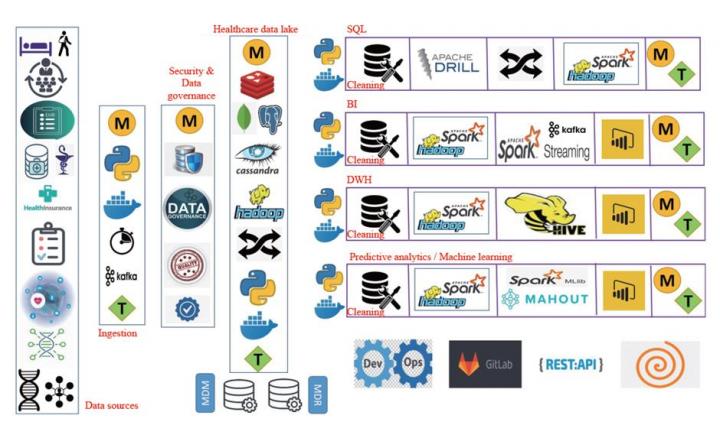Researchers propose a novel, standardized architecture for the implementation of big data analytics in healthcare

Credit: IEEE/CAA Journal of Automatica Sinica
The efficient provision of medical care is integral to society. Over time, the healthcare industry has tapped into modern technology in order to keep up its quality of service. This has, unsurprisingly, led to huge volumes of patient data. But it’s not just patients whose data need to be stored; doctors, physicians, clinical staff, and even smart wearable gadgets are contributing to what is coming to be known as “healthcare big data.”
Big data analytics (BDA), which involves the use of special design architectures to manage, store, and analyze complex data, is an important tool in healthcare. But it is hard to implement, owing to its high failure rate, resource-intensive process, and–most importantly–a lack of a clear guideline to aid practitioners.
In a recent study published in IEEE/CAA Journal of Automatica Sinica (Volume 8, Issue 1, January 2021), researchers from Pakistan and Australia addressed this issue, offering a roadmap for the successful implementation of BDA in healthcare. They proposed a standard architecture that promises to solve all the challenges currently associated with BDA. Prof. Tariq Mahmood from Institute of Business Administration (IBA), Pakistan, lays down his motivation behind the study, “In reality, healthcare analytics has been in use for more than two decades but has not yet catered for healthcare big data. In our study, we proposed an architecture that has the potential to solve a large number of healthcare analytics problems in the next 5 years.”
In the past, researchers have attempted to summarize the research work on BDA applications to improve patient healthcare. The summarization is ideally accomplished through a systematic and standardized review of published academic research papers. In the present study, the team took this approach to the next level by conducting the review through five different activities: 1) focusing on the use of all big data technologies, 2) identifying all limitations and challenges mentioned in previous studies, 3) proposing a novel, state-of-the-art design architecture called “Med-BDA” to solve these challenges, 4) identifying strategies for its successful implementation in the healthcare domain, and 5) comparing their work with all previously published studies.
The new Med-BDA architecture uses “Apache Spark technology” to analyze not only data in real time but also non-real-time data along with social network data to understand the bottlenecks of treatment process and make critical predictions regarding, for instance, in-patient cost estimates and expected mortality. Doctors can use these predictions to anticipate the patient’s condition in real time and provide them with better and effective treatments. Moreover, by comparing their work with selected papers, the researchers confirmed that their Med-BDA architecture was unique, with no similar strategies proposed previously.
The research team is excited about the future prospects of Med-BDA. Prof. Mahmood says, “Med-BDA can digest gigabytes of information collectively from different sources and analyze them concurrently to build a clear picture of the patients’ treatment processes for both real-time and batch-level analyses. Moreover, with the increasing popularity of ‘Internet-of-Things’ (IoT) in healthcare, Med-BDA will have the potential to digest big IoT data and thus improve BDA.”
Perhaps, we’re on the brink of a “big” revolution in healthcare!
###
Reference
S. Imran, T. Mahmood, A. Morshed, and T. Sellis, “Big data analytics in healthcare — A systematic literature review and roadmap for practical implementation,” IEEE/CAA J. Autom. Sinica, vol. 8, no. 1, pp. 1-22, Jan. 2021.
Fulltext of the paper is available:
https:/
IEEE/CAA Journal of Automatica Sinica aims to publish high-quality, high-interest, far-reaching research achievements globally, and provide an international forum for the presentation of original ideas and recent results related to all aspects of automation.
The first Impact Factor of IEEE/CAA Journal of Automatica Sinica is 5.129, ranking among Top 17% (11/63, SCI Q1) in the category of Automation & Control Systems, according to the latest Journal Citation Reports released by Clarivate Analytics in 2020. In addition, its latest CiteScore is 8.3, and has entered Q1 in all three categories it belongs to (Information System, Control and Systems Engineering, Artificial Intelligence) since 2018.
Why publish with us: Fast and high quality peer review; Simple and effective online submission system; Widest possible global dissemination of your research; Indexed in SCIE, EI, IEEE, Scopus, Inspec.
JAS papers can be found at http://ieeexplore.
Media Contact
Yan Ou
[email protected]




